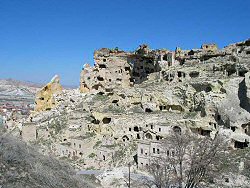|
|
|
|
|
 Çavuşin
is a village about 4 kilometres from Göreme. The
Çavuşin
is a village about 4 kilometres from Göreme. The ![]() old village is largely deserted because the area has been plagued
by rock falls. For this reason it is best to take a guide if you want
to visit Çavuşin and to watch your step. At Çavuşin you can visit
the Church of John the Baptist which probably dates from the 5th century
with paintings from the 6th, 7th and 8th centuries.
old village is largely deserted because the area has been plagued
by rock falls. For this reason it is best to take a guide if you want
to visit Çavuşin and to watch your step. At Çavuşin you can visit
the Church of John the Baptist which probably dates from the 5th century
with paintings from the 6th, 7th and 8th centuries.
Quite nearby another church contains frescos commemorating the passage
of ![]() Nicephoras Phocas (a Byzantine Emperor) through Cappadocia in
964 to 965 during his military campaign against Cilicia. Nicephoras
may have visited the Church of John the Baptist which was an important
centre for pilgrimage at that time.
Nicephoras Phocas (a Byzantine Emperor) through Cappadocia in
964 to 965 during his military campaign against Cilicia. Nicephoras
may have visited the Church of John the Baptist which was an important
centre for pilgrimage at that time.
Zelve, which once housed one of the largest communities in the region is an amazing cave town, honeycombed with dwellings, religious and secular chambers. Here, the Christians and Moslems lived together in perfect harmony, until 1924.Then Christians had to leave the Valley because of the exchange of minorities between Greece and Turkey, and the Moslems were forced to evacuate the Valley in the 50s when life became dangerous due to risk of erosion. They left the site to set up a modern village, a little further on, to which they gave the name Yeni Zelve (New Zelve).Now old Zelve is a ghost town and the erosion still continues.
The three valleys in the Zelve region are a paradise for the rock climbers. It takes at least two hours for a good trekker to walk through these valleys, which also house the oldest examples of Cappadocian architecture and religious paintings.
Start your excursion by visiting the first valley on the right taking the stamps in the second valley, then turning right. While walking along the path, you will see on the right some paintings on the surface of the rock. These paintings on the surface of the rock. These paintings are what remain from the now totally collapsed Geyikli Kilise (the Church with the Deer) and afford examples of the oldest paintings displaying the principal religious symbols of Christianity, like the Cross, the deer and the fish.
On entering the first valley you will see a rock-cut mosque on the left, with a lovely minaret obviously influenced by the bell-towers of the monasteries, (Byzantine ciboria) which consist of a baldachin of four collonettes supporting a pinnacle. You will then notice a monastery complex on the right resembling an upside down bowl cut of the rock. Immediately opposite, there is a rock-cut complex accessible by a metal ladder and connected to the second valley by a tunnel, but safety considerations make any attempt to go thought it inadvisable. On leaving the first valley you can enter the second valley by following the path in front of the Mosque.
Before leaving this open-air museum, be sure to pay special attention to the rocks at the entrance of the third valley. Here you will find a rock-cut mill with a grindstone which remained in use until the 50s. Recently, its entrance has collapsed. Then follow the path to the Üzümlü Kilise (The Church with Grapes) named after the bunches of grapes, a symbol representing Christ himself, in a country famous for its Dionysiac rituals. Just next to Üzümlü Kilise is the Balıklı Kilise (The Church with Fishes).On the apse above you will be able to discern paintings of fish in a very faded red.
![]() The nearby Paşabağ
area contains some of the most striking fairy chimneys
in Cappadocia with twin and even triple rock caps.
The nearby Paşabağ
area contains some of the most striking fairy chimneys
in Cappadocia with twin and even triple rock caps.
| |
Our Hotel | Turkey | Cappadocia | Daily Tours | Views | Guestbook | Request Form | Home |